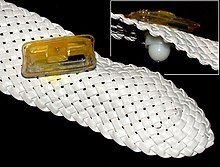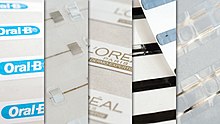Article security label
An article surveillance label is part of an article surveillance system in retail. Attached to the goods , it ensures that in the event of theft either an alarm is triggered or the goods are rendered unusable. Security labels are removed or deactivated during the regular payment process.
history
In the Federal Republic of Germany, new electronic security labels were used at the end of 1987. The label had a circumference of 62 × 19 mm and was also used for pricing. When leaving the security area formed by locks, it triggers an optical and / or acoustic alarm if it has not been deactivated beforehand. In 1987, only 20 to 30% of a department store range could be secured, including mostly textiles and leather goods, for other items the labels were previously too large and unsafe.
Mechanical security label
Mechanical labels often contain a color cartridge. They can only be removed with a special tool or with a considerable expenditure of time. In the system shown, this is a strong magnet, usually built into the counter, which pulls the inner tin cap back against the spring force and releases a retaining pin that is clamped between the balls. If they are broken open by force, the ink cartridge is emptied. Textiles are discolored in this way and made unusable. Mechanical security tags may prevent repeat theft.
Mechanical security labels often also contain a coil and an RFID chip as a combination of mechanical and electronic security systems.
Such mechanical systems are reusable.
Electronic article surveillance label
An electronic article security label of an electronic article security system (EAS) triggers an alarm when the secured article approaches an antenna . Antenna systems for detection are usually located between the cash register and the exit of the store in order to report unpaid goods. Security labels can be deactivated or removed by the cashier.
The trend in retail security is to integrate the corresponding security elements directly into the product or the product packaging. This so-called source tagging restricts the manipulation options and reduces the costs for attachment.
The following electronic article surveillance systems are currently on the market: radio frequency (RF), electromagnetic (EM), acoustomagnetic (AM) labels and RFID tags.
Radio resonance method
An RF label has an EAN (European Article Number) or a dummy imprint on the top . A shiny silver spiral can be seen on the back; this is a coil that also serves as an antenna. The blue bar in the picture connects the beginning and the end of the coil with a capacitor . Coil and capacitor form an oscillating circuit with the typical label resonance frequency.
The lock after the cash registers generates a magnetic high-frequency field that is periodically frequency-modulated. The oscillating circuit extracts transmission energy from the system precisely and only when the swept frequency corresponds to its resonance frequency (typically around 8.2 MHz ) and can thus be detected using the periodic steep increases in absorption (see also resonance absorption and dipmeter ). The periodic resonance absorption can be used to distinguish the label from other HF-absorbing objects.
After purchasing the goods, the label must be deactivated in order not to trigger a false alarm. This is done either mechanically (removing the label, cutting the coil) or electrically (inducing high currents that irreversibly change the capacitor and thus detune the resonant circuit).
RF tags have several disadvantages, such as their size and poor selectivity. Various mobile electronic devices such as hearing aids, radios or cell phones can also randomly represent resonance circuits on the detection frequency with their electrical circuits. In these cases an undesired false alarm is triggered. Unfavorable orientation relative to the antennas or manipulative shielding by metal mean that only 70 percent of the active labels are recognized. This speaks against their safety function. By shielding the label, a magnetic field no longer reaches the coil and the resonant circuit is no longer excited, so that the label is invisible to the detection system.
Once deactivated, RF tags cannot be used again. The advantage is their low price (approx. 3ct in the final sale.)
There are also so-called hard tags. These are disc-shaped objects made of plastic that are attached to textile goods with a safety pin. They contain a resonant circuit made up of a coil and a ceramic capacitor. These labels are removed and reused at the checkout after purchase. The safety pin makes it seemingly impossible for the thief to remove the label without damaging the goods.
These tags are unlocked at the cash register with a strong magnet. B. Balls, which hold the safety pin by means of a spring force, are withdrawn and release the needle.
Advanced systems recognize manipulations and then give an alarm in the store. Such tags can also be attached by means of a locked wire loop.
Electromagnetic or harmonic process
EM labels can be based on the harmonic system as well as on the magnetic Barkhausen effect .
The labels can be activated and deactivated reversibly. The short metal strips are magnetically hard and unmagnetized when active. To deactivate the label, they are exposed to a constant magnetic field, which makes them permanently magnetic . They then keep the soft magnetic long metal strip in saturation so that it can no longer follow a reversal of magnetization caused by an external field and no longer generates harmonics. Different arrangements of the hard magnetic sections along the metal strip also result in other arrangements of the patterns of harmonics, which can be used to differentiate between different product groups, for example. The very thin labels (0.02 mm) do not have to lie in a plastic box like AM labels and are insensitive to kinks. Tagit SA improved the EM systems and labels based on the Barkhausen effect. What was considered physically unsolvable was achieved in 2003 by the company that registered its three-dimensional EM system as a patent in the USA .
EM systems are suitable for libraries to protect books and media. In retail, unlike AM and RF, EM can protect small or round items and products with foil packaging or metal items such as cosmetics, baby milk cans, medicines, home improvement tools, household appliances, etc. Articles in metal briefcases or objects in foil are also recognized.
Another application is the protection of intellectual property against theft and industrial espionage through security paper with embedded microwires, which is used to detect confidential documents when they are removed from a building.
Acoustomagnetic process
The picture shows an acousto-magnetic label (AM label) that the manufacturer had already incorporated into a textile label as part of the source tagging. If you cut open the label (picture on the right), two loosely inserted amorphous metal strips emerge with the current so-called DR labels (one with older so-called LE labels) . The third metal strip, seen in the picture in the front, is held by a plastic film at a distance from the loose strips. An alternating magnetic field generated by the coils at the lock causes the amorphous metal strips to vibrate mechanically through magnetostriction . In the case of resonance, they continue to vibrate for a short time after the excitation has ended. The reverberation in turn generates an alternating magnetic field that is received by the same coils.
The resonance frequency of the metal strips and thus also the excitation frequency of the magnetic field is typically 58 kHz, the pulse repetition frequency around 45 Hz. The excitation takes 2 ms. For 5 ms the coils of the lock try to detect ringing signals in order to emit the magnetic alternating field again for 2 ms after another 15 ms.
The third (second for LE labels) metal strip, which is firmly connected to the housing, consists of a magnetically hard material. If it is permanently magnetic, the mechanical resonance frequency coincides with that of the stimulating alternating magnetic field, and the label is active. Demagnetization of the metal strip detunes the label, it is deactivated. In contrast to EM labels, you can choose whether an AM label should be activated or deactivated when magnetized. The determination of the resonance frequency followed the consideration that demagnetization is much more difficult to accomplish than magnetization for a possible thief.
Deactivation takes place at the checkout by holding the goods in a strong alternating magnetic field. This will demagnetize the label.
AM labels (DR labels) have a retail price of around 4.5 cents.
RFID process
While the above-mentioned labels only convey one bit of information, namely activated or deactivated , an RFID label can, for example, send a stored number that often not only stands for the product group but also for the individual article. The receiving system can therefore compare this number with the number read out during payment or obtain logistic information from it.
The label consists of an antenna with a resonance circuit and an integrated circuit (chip). The resonance circuit supplies the chip with energy via the RF radiation from the detection system. At the same time, data is transmitted between the microchip and the detection device in that the chip modulates the damping of the resonant circuit. The RFID chip often also stores data itself, in the simplest case the information “pays” after data communication at the cash register.
The RFID tags can also be read after paying for the goods and leaving the shop, which can represent a data protection problem depending on the stored data .
See also
- Magnetic Barkhausen effect - another physical phenomenon that can be used in EAS systems.
Web links
- Giselher Herzer: The great eavesdropping on shoplifters . In: Physikalische Blätter , 57, 2001, No. 5, pp. 43-48, vacuumschmelze.de (PDF; 937 kB). Description of the physical basics of security labels.
Individual evidence
- ↑ http://www.eastek-onlineshop.de/epages/61471765.sf/de_DE/?ObjectPath=/Shops/61471765/Products/%22010039%20Uni%20eu%22 29EUR per 1k, accessed in July 2014
- ↑ Tagit SA
- ↑ https://www.deutschlandfunk.de/sicherheitstechnik-mikoskopische-draehte-gegen.676.de.html?dram:article_id=431372
- ↑ http://www.eastek-onlineshop.de/epages/61471765.sf/de_DE/?ObjectPath=/Shops/61471765/Products/010126 (price per 1k 45 EUR in July 2014)








